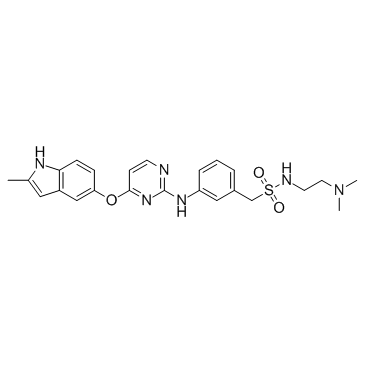| Cas No.: | 1308672-74-3 |
| Chemical Name: | Benzenemethanesulfonamide, N-[2-(dimethylamino)ethyl]-3-[[4-[(2-methyl-1H-indol-5-yl)oxy]-2-pyrimidinyl]amino]- |
| Synonyms: | HMPL-012;Surufatinib;HMPL012 |
| SMILES: | CC1NC2C=CC(OC3C=CN=C(NC4C=C(CS(NCCN(C)C)(=O)=O)C=CC=4)N=3)=CC=2C=1 |
| Formula: | C24H28N6O3S |
| M.Wt: | 480.5825 |
| Purity: | >98% |
| Sotrage: | 2 years -20°C Powder, 2 weeks 4°C in DMSO, 6 months -80°C in DMSO |
| Description: | Sulfatinib (HMPL-012) is a potent and highly selective tyrosine kinase inhibitor against VEGFR1/2/3, FGFR1 and CSF1R with IC50s of in a range of 1 to 24 nM. |
| Target: | VEGFR1 VEGFR2 VEGFR3 FGFR1 CSF1R |
| In Vivo: | In animal studies, a single oral dosing of Sulfatinib inhibits VEGF stimulated VEGFR2 phosphorylation in lung tissues of nude mice in an exposure-dependent manner. Furthermore, elevation of FGF23 levels in plasma 24 hours post dosing suggests suppression of FGFR signaling. Sulfatinib demonstrates potent tumor growth inhibition in multiple human xenograft models and decreases CD31 expression remarkably, suggesting strong inhibition on angiogenesis through VEGFR and FGFR signaling. In a syngeneic murine colon cancer model CT-26, Sulfatinib demonstrates moderate tumor growth inhibition after single agent treatment[1]. After oral dosing of 10 mg/kg, the AUC and Cmax are 397 ng/mL and 138ng/mL in the mouse, respectively[1]. |
| In Vitro: | Sulfatinib inhibits VEGFR1, 2, and 3, FGFR1 and CSF1R kinases with IC50s in a range of 1 to 24 nM, and it strongly blocks VEGF induced VEGFR2 phosphorylation in HEK293KDR cells and CSF1 stimulated CSF1R phosphorylation in RAW264.7 cells with IC50 of 2 and 79 nM, respectively. Sulfatinib also attenuates VEGF or FGF stimulated HUVEC cells proliferation with IC50< 50 nM[1]. Also, it is a hERG inhibitor with IC50 of 6.8 μM in CHO cell[2]. |
| Kinase Assay: | In animal studies, a single oral dosing of Sulfatinib inhibits VEGF stimulated VEGFR2 phosphorylation in lung tissues of nude mice in an exposure-dependent manner. Furthermore, elevation of FGF23 levels in plasma 24 hours post dosing suggests suppression of FGFR signaling. Sulfatinib demonstrates potent tumor growth inhibition in multiple human xenograft models and decreases CD31 expression remarkably, suggesting strong inhibition on angiogenesis through VEGFR and FGFR signaling. In a syngeneic murine colon cancer model CT-26, Sulfatinib demonstrates moderate tumor growth inhibition after single agent treatment[1]. After oral dosing of 10 mg/kg, the AUC and Cmax are 397 ng/mL and 138ng/mL in the mouse, respectively[1]. |
| Cell Assay: | The phamacokinetics of Sulfatinib are studied with male ICR mice (n=6 for each group, weight 20-30g) after a single intraveneous and oral dosing at 2.5 and 10mg/kg, respectively. For i.v. dosing formulation, Sulfatinib is dissolved in DMSO (0.25%)-solutol(10%)-ethanol(10%)-physiological saline(79.75%) at the concentration of 0.25 mg/mL. And the p.o. Dosing formulation (1mg/mL) is prepared with 0.5% CMC-Na. After i.v. Or p.o. Dosing, blood samples are collected via the ophthalmic vein at 0 (pre-close), 5, 15, 30 min and 1, 1.5, 2, 4, 8, 24 h, anti-coagulated with heparin-Na. After centrifugation, plasma samples are seprated and protein precipitated with acetonitrilel containing internal standard[2]. |
| References: | [1]. PCT Int. Appl. (2011), WO 2011060746 A1 20110526. |

 DC Chemicals' products qualify for U.S. tariff exemptions. We guarantee no price increases due to customs duties and maintain stable supply, continuing to deliver reliable research solutions to our American clients.
DC Chemicals' products qualify for U.S. tariff exemptions. We guarantee no price increases due to customs duties and maintain stable supply, continuing to deliver reliable research solutions to our American clients.





















